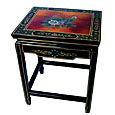Furniture Design Trends
Global and environmental awareness are driving trends in furniture design and finishing.

Many factors go into predicting the styles and colors that will captivate consumers. Shifts in economics and world politics are traditional barometers of consumer mood and mindset. Add to that today’s constant barrage of information from media sources, and you have consumers who are acutely aware of the world around them and their impact on the world.
This piece-by-piece approach to decorating allows consumers to create home environments that are unique. Consumers also are less likely to create obvious “ethnic” settings, opting instead for dramatic accent pieces from different cultures and using them side by side. Even if homeowners are not seasoned travelers, their home decor might look as if they are.
The spa influence, though very strong over the last few years with heavy emphasis on pampering and high luxury, is waning, giving way to environments that reflect a broader worldview. A mix of textures in home surfaces, such as smooth cabinetry with rustic, rough-sawn walls will be popular in the next few years. Use of exotic woods (such as bamboo) is becoming more prevalent due to the increase of overseas manufacturing with wood species not indigenous to North America.
Multi-step finishing processes, such as those that include glazing, underscore the importance of each individual piece. Consumers are gravitating toward pieces that look handmade as opposed to uniform, mass-produced finishes. Finishing effects vary greatly, depending on each step in the multi-step finishing process and the sophistication of technique in the execution of each step. Glazing, for example, often deepens the color of the wood grain, adding depth and richness, as well as contrast. Overall, wood finishes are gravitating toward darker, richer tones combined with accents that give each piece an artisan, handcrafted appearance, trending toward higher sheens and glosses.

Consumers are also taking a closer look at the products they buy indirectly. For instance, not only are they interested in what paint finish is used on their walls, but they also want to know about the finishes used on their kitchen cabinets. Such information is being made more readily available to consumers to help them support products that are environmentally preferable.
Manufacturers of all types of durable goods have been working to meet strict new standards for air and water quality while fulfilling consumer demand for products that are environmentally preferable, attractive and useful. The furniture industry in particular has increased efforts to reduce, reuse and recycle.
The finishing industry also has taken a proactive role, with manufacturers providing the woodworking industry with finishes that have low VOCs and no HAPs. New formulations of coatings without formaldehyde or heavy metals help woodworking businesses comply with local and federal Clean Air Act mandates. In addition, these coatings are designed with environmental advantages since manufacturers can reclaim overspray and minimize product waste and disposal costs.
Where color is concerned, consumers who are “going green” are not surprisingly showing a preference for the color green and other earth tones. The greening of America is also driving consumer preferences for wood furnishings since wood is an obvious and natural tie to the environment.
In addition to bigger homes, more Americans than ever have become homeowners. With homeownership comes the need for furnishings. Another plus for the furniture industry is that as consumers’ earnings increase, they often upgrade furnishings to create home environments that are more comfortable and inviting.
While the trends mentioned here are significant, they are not by any means the only trends impacting consumers and the woodworking industry. For example, two ends of the consumer spectrum, the youth and senior markets, are having an impact on what consumers want to buy. Parents are eager to please their children with furnishings that reflect pop culture, while mature buyers are either looking into furnishing second homes or are replacing existing furnishings.
In addition, consumer demand for flat screen TVs and new and better ways to view movies, listen to music and play video games has driven growth in the market for audio-visual furniture with accommodations for sound systems and storage areas for DVDs, CDs and video games.
All of these trends bode well for the woodworking industry. But most important is the furniture makers’ ability to quickly adapt to these trends in order to give consumers what they want.

Today’s consumers are choosing furniture that is exotic and eclectic.
Many factors go into predicting the styles and colors that will captivate consumers. Shifts in economics and world politics are traditional barometers of consumer mood and mindset. Add to that today’s constant barrage of information from media sources, and you have consumers who are acutely aware of the world around them and their impact on the world.
Global Awareness
More than ever, consumers are taking a global perspective in decorating and furnishing their homes. Interest in furniture that is exotic and eclectic is strong and is pushing aside the tendency to purchase furniture groupings in any one style. Rather, today’s sophisticated consumer wants an interesting mix of styles and colors that reflect individuality.This piece-by-piece approach to decorating allows consumers to create home environments that are unique. Consumers also are less likely to create obvious “ethnic” settings, opting instead for dramatic accent pieces from different cultures and using them side by side. Even if homeowners are not seasoned travelers, their home decor might look as if they are.
The spa influence, though very strong over the last few years with heavy emphasis on pampering and high luxury, is waning, giving way to environments that reflect a broader worldview. A mix of textures in home surfaces, such as smooth cabinetry with rustic, rough-sawn walls will be popular in the next few years. Use of exotic woods (such as bamboo) is becoming more prevalent due to the increase of overseas manufacturing with wood species not indigenous to North America.
Multi-step finishing processes, such as those that include glazing, underscore the importance of each individual piece. Consumers are gravitating toward pieces that look handmade as opposed to uniform, mass-produced finishes. Finishing effects vary greatly, depending on each step in the multi-step finishing process and the sophistication of technique in the execution of each step. Glazing, for example, often deepens the color of the wood grain, adding depth and richness, as well as contrast. Overall, wood finishes are gravitating toward darker, richer tones combined with accents that give each piece an artisan, handcrafted appearance, trending toward higher sheens and glosses.

Consumers are gravitating toward pieces that look handmade, rather than mass-produced finishes.
Going Green
Whether at the grassroots level of local politics or at international summits, protecting the environment ranks high on many agendas. Even though attention to the environment is nothing new, consumers are increasingly becoming aware of their individual impact on the planet. Energy-efficient homes and appliances, hybrid cars and recycling are just some of the choices consumers are making to participate in the popular movement to conserve and protect resources.Consumers are also taking a closer look at the products they buy indirectly. For instance, not only are they interested in what paint finish is used on their walls, but they also want to know about the finishes used on their kitchen cabinets. Such information is being made more readily available to consumers to help them support products that are environmentally preferable.
Manufacturers of all types of durable goods have been working to meet strict new standards for air and water quality while fulfilling consumer demand for products that are environmentally preferable, attractive and useful. The furniture industry in particular has increased efforts to reduce, reuse and recycle.
The finishing industry also has taken a proactive role, with manufacturers providing the woodworking industry with finishes that have low VOCs and no HAPs. New formulations of coatings without formaldehyde or heavy metals help woodworking businesses comply with local and federal Clean Air Act mandates. In addition, these coatings are designed with environmental advantages since manufacturers can reclaim overspray and minimize product waste and disposal costs.
Where color is concerned, consumers who are “going green” are not surprisingly showing a preference for the color green and other earth tones. The greening of America is also driving consumer preferences for wood furnishings since wood is an obvious and natural tie to the environment.
The American Dream Home
Fifty years ago, a three-bedroom home with one bathroom was the standard most Americans strived to achieve. Today, the average size of the American home has more than doubled. According to the National Association of Home Builders (NAHB), the average home in the 1950s was 983 ft2. In contrast, NAHB’s latest figures from 2004 show that the average American home was 2,349 ft2. Even though the trend for bigger homes seems incongruous with an interest in “saving the planet,” the numbers and research show that many consumers want it both ways. Either way, bigger homes mean that consumers will need to buy more furnishings to fill that extra space. According to Global Wood Trade Network, household furniture purchases have significantly increased from over $23 billion in 1983 to more than $71 billion in 2003.In addition to bigger homes, more Americans than ever have become homeowners. With homeownership comes the need for furnishings. Another plus for the furniture industry is that as consumers’ earnings increase, they often upgrade furnishings to create home environments that are more comfortable and inviting.
While the trends mentioned here are significant, they are not by any means the only trends impacting consumers and the woodworking industry. For example, two ends of the consumer spectrum, the youth and senior markets, are having an impact on what consumers want to buy. Parents are eager to please their children with furnishings that reflect pop culture, while mature buyers are either looking into furnishing second homes or are replacing existing furnishings.
In addition, consumer demand for flat screen TVs and new and better ways to view movies, listen to music and play video games has driven growth in the market for audio-visual furniture with accommodations for sound systems and storage areas for DVDs, CDs and video games.
All of these trends bode well for the woodworking industry. But most important is the furniture makers’ ability to quickly adapt to these trends in order to give consumers what they want.
Looking for a reprint of this article?
From high-res PDFs to custom plaques, order your copy today!






